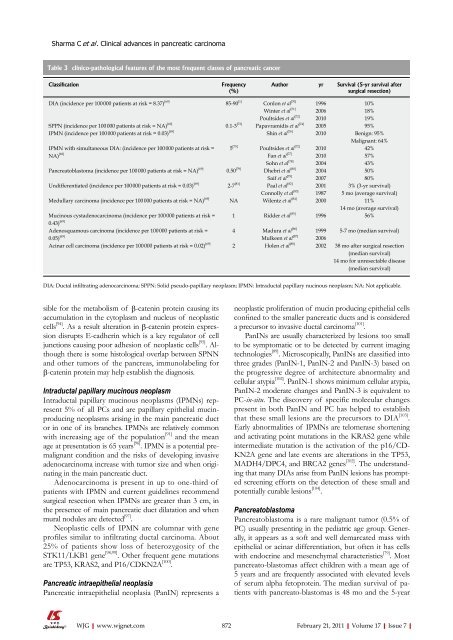Management of stage Ⅳ rectal cancer - World Journal of ...
Management of stage Ⅳ rectal cancer - World Journal of ...
Management of stage Ⅳ rectal cancer - World Journal of ...
You also want an ePaper? Increase the reach of your titles
YUMPU automatically turns print PDFs into web optimized ePapers that Google loves.
Sharma C et al . Clinical advances in pancreatic carcinoma<br />
Table 3 clinico-pathological features <strong>of</strong> the most frequent classes <strong>of</strong> pancreatic <strong>cancer</strong><br />
Classification Frequency<br />
(%)<br />
DIA (incidence per 100 000 patients at risk = 8.37) [69]<br />
SPPN (incidence per 100 000 patients at risk = NA) [69]<br />
IPMN (incidence per 100 000 patients at risk = 0.03) [69]<br />
IPMN with simultaneous DIA: (incidence per 100 000 patients at risk =<br />
NA) [69]<br />
Pancreatoblastoma (incidence per 100 000 patients at risk = NA) [69]<br />
Undifferentiated (incidence per 100 000 patients at risk = 0.03) [69]<br />
Medullary carcinoma (incidence per 100 000 patients at risk = NA) [69]<br />
Mucinous cystadenocarcinoma (incidence per 100 000 patients at risk =<br />
0.43) [69]<br />
Adenosquamous carcinoma (incidence per 100 000 patients at risk =<br />
0.05) [69]<br />
Acinar cell carcinoma (incidence per 100 000 patients at risk = 0.02) [69]<br />
sible for the metabolism <strong>of</strong> β-catenin protein causing its<br />
accumulation in the cytoplasm and nucleus <strong>of</strong> neoplastic<br />
cells [94] . As a result alteration in β-catenin protein expression<br />
disrupts E-cadherin which is a key regulator <strong>of</strong> cell<br />
junctions causing poor adhesion <strong>of</strong> neoplastic cells [95] . Although<br />
there is some histological overlap between SPNN<br />
and other tumors <strong>of</strong> the pancreas, immunolabeling for<br />
β-catenin protein may help establish the diagnosis.<br />
Intraductal papillary mucinous neoplasm<br />
Intraductal papillary mucinous neoplasms (IPMNs) represent<br />
5% <strong>of</strong> all PCs and are papillary epithelial mucinproducing<br />
neoplasms arising in the main pancreatic duct<br />
or in one <strong>of</strong> its branches. IPMNs are relatively common<br />
with increasing age <strong>of</strong> the population [91] and the mean<br />
age at presentation is 65 years [96] . IPMN is a potential premalignant<br />
condition and the risks <strong>of</strong> developing invasive<br />
adenocarcinoma increase with tumor size and when originating<br />
in the main pancreatic duct.<br />
Adenocarcinoma is present in up to one-third <strong>of</strong><br />
patients with IPMN and current guidelines recommend<br />
surgical resection when IPMNs are greater than 3 cm, in<br />
the presence <strong>of</strong> main pancreatic duct dilatation and when<br />
mural nodules are detected [97] .<br />
Neoplastic cells <strong>of</strong> IPMN are columnar with gene<br />
pr<strong>of</strong>iles similar to infiltrating ductal carcinoma. About<br />
25% <strong>of</strong> patients show loss <strong>of</strong> heterozygosity <strong>of</strong> the<br />
STK11/LKB1 gene [98,99] . Other frequent gene mutations<br />
are TP53, KRAS2, and P16/CDKN2A [100] .<br />
Pancreatic intraepithelial neoplasia<br />
Pancreatic intraepithelial neoplasia (PanIN) represents a<br />
WJG|www.wjgnet.com<br />
85-90 [1]<br />
0.1-3 [73]<br />
0.50 [79]<br />
Author yr Survival (5-yr survival after<br />
surgical resection)<br />
Conlon et al [70]<br />
Winter et al [71]<br />
Poultsides et al [72]<br />
Papavramidis et al [74]<br />
Shin et al [76]<br />
5 [75]<br />
Poultsides et al [72]<br />
Fan et al [77]<br />
Sohn et al [78]<br />
Dhebri et al [80]<br />
Saif et al [79]<br />
Paal et al [82]<br />
Connolly et al [83]<br />
NA Wilentz et al [84]<br />
2-7 [81]<br />
1 Ridder et al [85]<br />
4 Madura et al [86]<br />
Mulkeen et al [87]<br />
2 Holen et al [88]<br />
1996 10%<br />
2006 18%<br />
2010 19%<br />
2005 95%<br />
2010 Benign: 95%<br />
Malignant: 64%<br />
2010 42%<br />
2010 57%<br />
2004 43%<br />
2004 50%<br />
2007 80%<br />
2001 3% (3-yr survival)<br />
1987 5 mo (average survival)<br />
2000 11%<br />
14 mo (average survival)<br />
1996 56%<br />
1999 5-7 mo (median survival)<br />
2006<br />
2002 38 mo after surgical resection<br />
(median survival)<br />
14 mo for unresectable disease<br />
(median survival)<br />
DIA: Ductal infiltrating adenocarcinoma; SPPN: Solid pseudo-papillary neoplasm; IPMN: Intraductal papillary nucinous neoplasm; NA: Not applicable.<br />
neoplastic proliferation <strong>of</strong> mucin producing epithelial cells<br />
confined to the smaller pancreatic ducts and is considered<br />
a precursor to invasive ductal carcinoma [101] .<br />
PanINs are usually characterized by lesions too small<br />
to be symptomatic or to be detected by current imaging<br />
technologies [89] . Microscopically, PanINs are classified into<br />
three grades (PanIN-1, PanIN-2 and PanIN-3) based on<br />
the progressive degree <strong>of</strong> architecture abnormality and<br />
cellular atypia [102] . PanIN-1 shows minimum cellular atypia,<br />
PanIN-2 moderate changes and PanIN-3 is equivalent to<br />
PC-in-situ. The discovery <strong>of</strong> specific molecular changes<br />
present in both PanIN and PC has helped to establish<br />
that these small lesions are the precursors to DIA [103] .<br />
Early abnormalities <strong>of</strong> IPMNs are telomerase shortening<br />
and activating point mutations in the KRAS2 gene while<br />
intermediate mutation is the activation <strong>of</strong> the p16/CD-<br />
KN2A gene and late events are alterations in the TP53,<br />
MADH4/DPC4, and BRCA2 genes [102] . The understanding<br />
that many DIAs arise from PanIN lesions has prompted<br />
screening efforts on the detection <strong>of</strong> these small and<br />
potentially curable lesions [104] .<br />
Pancreatoblastoma<br />
Pancreatoblastoma is a rare malignant tumor (0.5% <strong>of</strong><br />
PC) usually presenting in the pediatric age group. Generally,<br />
it appears as a s<strong>of</strong>t and well demarcated mass with<br />
epithelial or acinar differentiation, but <strong>of</strong>ten it has cells<br />
with endocrine and mesenchymal characteristics [79] . Most<br />
pancreato-blastomas affect children with a mean age <strong>of</strong><br />
5 years and are frequently associated with elevated levels<br />
<strong>of</strong> serum alpha fetoprotein. The median survival <strong>of</strong> patients<br />
with pancreato-blastomas is 48 mo and the 5-year<br />
872 February 21, 2011|Volume 17|Issue 7|

















